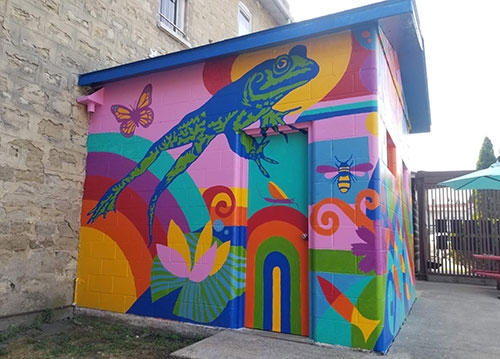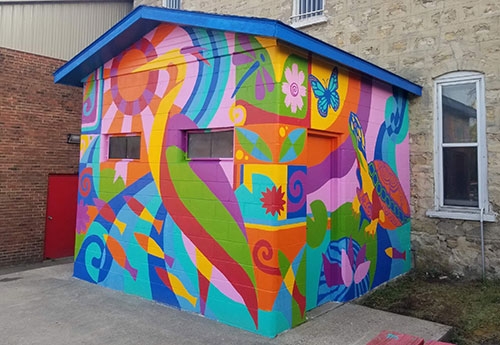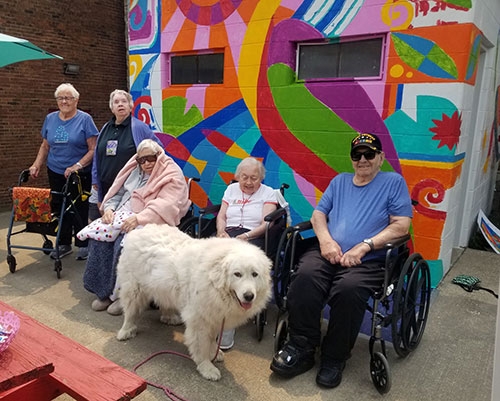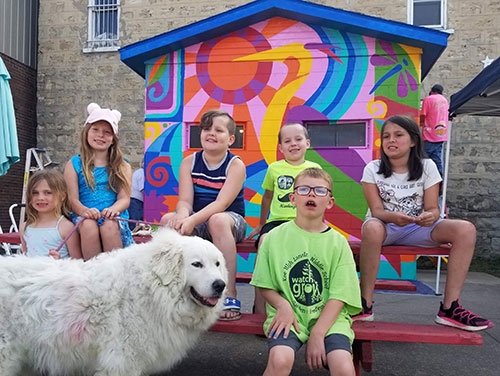You are here
Home ›Great Blue Heron Mural public art project brings people of all ages and backgrounds together to create an artistic celebration of the natural beauty of the Mississippi River

Public art project involves nearly 100 community members ... Side and front views of the public restroom along Front Street in Lansing show how the once plain white building has been brought to vibrant life through the Great Blue Heron Mural public art project that took place June 15-18. Coordinated by artist and pastor of Our Savior’s Lutheran Church in Lansing Laura Gentry, the four-day project involved nearly 100 community members who volunteered 262 hours of their time to complete the project, which has been described as a “celebration of the natural beauty of the Mississippi River.” Submitted photos.


Bringing generations together ... The Great Blue Heron Mural public art project involved nearly 100 community members in painting the public restroom facility pictured in the background in each of the above photos and located along Front Street in Lansing. The project, which took place over a four-day period of June 15-18 this summer, brought together community members of all ages and backgrounds to participate in its painting, ranging from the experience of residents of Thornton Manor, pictured left to right in the photo above, Karen Milton, VJ Nelson, Cathy Batteen, Rosie Sweeney and Ken Leppert, to the youthful nature of members of Lansing’s Cub Scout Pack 47, pictured left to right in the photo below, Charlotte, Juniper, Clayton, Creed, Sam and Brooke, all pictured with Fuji, the dog of Laura Gentry, mural design creator and pastor of Our Savior’s Lutheran Church in Lansing. Submitted photos.

by Julie Berg-Raymond
What once was a nondescript, white cement-block building facing the Mississippi River on Lansing’s Front Street - a building which, interestingly, even a number of local residents had not realized houses a public restroom - recently was transformed into a colorful, vibrant piece of public art thanks to the efforts of artist (and pastor of Our Savior’s Lutheran Church, in Lansing) Laura Gentry and a team of 98 community members.
The art project - entitled The Great Blue Heron Mural - was funded by grant monies and financial support from Lansing Office Works, Kerndt Brothers Savings Bank, K Cromwell Art, Our Savior’s Lutheran Church, Driftless Integrative Psychiatry, Steve Murray and Sarah Updegraff-Murray, and other donors. Volunteers logged a total of 262 hours, over a four-day period, painting in a “color-by-number” fashion the design that Gentry had created and then superimposed on the building. Among the volunteers who came to paint were Kerndt Brothers Bank employees, Lansing City Council members, staff from the The Good Life Gallery and Frame Shop, Cub Scouts, residents of Thornton Manor and parishioners from three local churches.
Gentry conceived the mural, itself, as what her project proposal called “a unique, site-specific plan featuring a Great Blue Heron and flowing water with fish, evoking the natural beauty of the Mississippi River.” Intricate and multi-colored images of a frog and a turtle also adorn each side of the building on the wrap-around mural that brings the building to life.
The design is a stylized interpretation of the wildlife in the Driftless Region, and is characterized by bold, bright color-blocking - a key element of Gentry’s design aesthetic. “I just love the joy and energy that colors bring to a space,” she says. “I hope [the mural] will be an attraction for tourists coming to enjoy the river.”
OTHER LEADERSHIP
Marsha Kurth, of La Crosse, WI (originally from northeast Iowa), headed the project’s organizing team - putting together an electronic sign-up tool for volunteers, handing out paints and brushes, and signing everyone in each day. “I was the ‘hostess,’” Kurth says. “I was there all four days, and the mood was always festive. I was surprised by how many people said they didn’t think they could paint but were willing to try.”
Kurth - who says she liked the idea of this being “an inter-generational community project” - has experience with collaborative art projects. As the director of a teen center in Decorah in the 1990s, she commissioned artist Carl Homstad to work with the center’s young people on a mural. “It turned out great, and the teens loved being involved,” she recalls.
Kurth was the person who contacted Thornton Manor, with the intention of getting seniors involved in the mural project. “I immediately said yes, without hesitation,” says Thornton Manor’s Recreation Therapy Director and Volunteer Coordinator Karen Ulrich. Six residents participated, with Ulrich, her assistant and administrator Sam Kuhn assisting, if needed, by holding the paint.
“The residents loved being part of the mural project, along with enjoying Pastor Laura’s huge, beautiful, loving dog during breaks from painting,” Ulrich says. “Members of the community drove by and waved; everyone was laughing, visiting, and enjoying every minute. We appreciate being thought of and invited to be part of this wonderful Lansing community event. The Great Blue Heron Mural will be a treasured memory for the residents and their families to share with the generations to come.”
PARTICIPANTS
Lansing City Council member Curtis Snitker, one of the council members who voted to approve the project, has been an active participant in community projects and says he valued this one, in particular, because of “a feeling of community coming together and helping beautify Lansing.” On the day he painted, the volunteers were joined by residents from Thornton Manor, who contributed to what he says was a fun, festive atmosphere.
“The goal is to beautify public space, develop an arts culture, and become a destination,” he says. He thinks the mural project will “encourage more art projects in Lansing through community involvement and also grow citizen pride. Public art is an expression of our inner soul, creating dialogue with artistic emotion.”
Having directed many plays at Kee High School, Marlene Duffy of Lansing brought years of experience with set design and construction to her involvement with the mural project. For Duffy, who painted with her daughter and two grandchildren, participation in this project was part of what she describes as a “lifelong faith journey.” Raised in the Catholic Church, she now is a member of Pastor Gentry’s congregation and says she was “looking for someone who walks the walk and doesn’t just talk the talk. I’m looking for the truth-seekers.”
Duffy says the beauty of a public art project like The Great Blue Heron Mural - by bringing the community together in artistic expression - is that “the mural, itself, opens up the perception that Lansing is opening its doors, its streets, its homes to everybody,” she says.
Lansing City Council member Lisa Welsh also voted to approve the art project and participated in its creation. “I have never done anything like this before, but I have read about many artists inviting community members to help with their art projects,” she says. “It was great seeing the many different people painting that day, which made it very fun and engaging. There was lots of chatter and we had so many people stop and compliment us on the beautiful colors and design.”
Welsh’s mother-in-law, Essie Welsh, along with three of her daughters, also participated that day, along with a past student of Welsh’s and her mother. “Pastor Buck was working on the frog on the south side of the building, which I heard he came every day and did, and completed the frog. When I was leaving, my sister-in-law, Kim Welsh, was bringing three of her grandchildren in to help paint. Marylou Baker, who teaches art education up at New Albin, was there also,” Welsh says. “I loved that I walked by and saw a group from the nursing home participating alongside young children. Pastor Laura put in a lot of prep time to make sure that anyone and everyone could be a part of this.”
PUBLIC ART – WHAT IT IS, AND WHY IT’S VALUABLE
According to information provided at the website for the Association for Public Art, “public art is a part of our public history, part of our evolving culture and our collective memory. It reflects and reveals our society and adds meaning to our cities. As artists respond to our times, they reflect their inner vision to the outside world, and they create a chronicle of our public experience” (associationforpublicart.org).
Furthermore, the website notes, “[i]n a diverse society, all art cannot appeal to all people, nor should it be expected to do so. Art attracts attention; that is what it is supposed to do … Varied popular opinion is inevitable, and it is a healthy sign that the public environment is acknowledged rather than ignored.”
Public art also has more tangible effects in communities. “Studies suggest public art has a profoundly positive impact on communities by supporting economic growth and sustainability, social cohesion and belonging,” Gentry notes. “It has the power to energize our public spaces, arouse our thinking and transform the places where we live, work, and play into more welcoming and beautiful environments that invite interaction.”
And, where the public is, itself, involved in the artistic process - as it was with the Great Blue Heron Mural, Gentry adds, “it will encourage community buy-in and pride in the project.”
“I love when I drive through towns and see art on buildings, and I am proud of Lansing for bringing beautiful art to our town,” says council member Welsh. “I feel so lucky to have someone as talented as Pastor Laura willing to give her time and share her talent, and let the community participate in the project. I love that I can tell people that I helped with that artwork.”
A short film regarding the project and its completion can be viewed online at Lansinglutherans.org.

